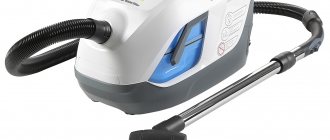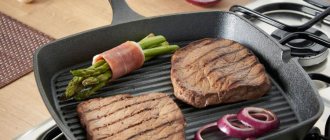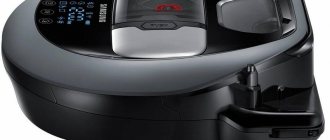In recent years, more and more people are thinking about purchasing a vacuum cleaner equipped with a cleaning function. Washing vacuum cleaners, along with dry cleaning, are capable of wet cleaning. Such devices can collect liquid, clean surfaces, upholstered furniture, curtains, glass, and humidify the air in the room.
With many useful features, these vacuum cleaners are easy to maintain and use. The market for these devices is represented by a large assortment of brands and models of any price category.
How the washing vacuum cleaner works
The operating principle of all washing vacuum cleaners is identical.
These vacuum cleaners have 2 reservoirs:
- A special container is filled with water and detergents.
- The second tank is intended for dirty water.
The spraying itself occurs using a capillary tube, which is attached to the handle and at the base of the nozzle. There is a special hole on the nozzle - a narrow nozzle through which spraying water is sucked in along with dirt.
Some models are equipped with an additional mechanical filter, which is designed to collect large debris.
The location of water tanks can be different:
- vertical;
- horizontal;
- one container into another.
Operating principle of washing vacuum cleaners:
- the tank is filled with running water;
- using a special nozzle, clean water is sprayed onto the surface, after which the dust suction mode is turned on along with water into a tank specially designed for this purpose;
- To clean fabric surfaces, a special cleaning agent is added to the water (the proportions are indicated in the instructions). The air flow pressure created by the device makes it possible to clean carpets to the full depth of the pile;
- when using the unit in dry cleaning mode, debris is collected in a bag (if provided in the design) or a waste water tank, which also doubles as a filter. In this case, the air passing through the filter is cleaned. This mode is used when cleaning surfaces that are sensitive to moisture.
Washing vacuum cleaner device
Today there are four main types of washing vacuum cleaners on the market:
- Professional - they have quite impressive sizes and high power. In addition to the main functions, they are often equipped with an additional option for floor drying;
- For carpets and carpeted floor coverings;
- For fabrics - they have small dimensions, thanks to which they are easily transported to items that need cleaning;
- Foam extractors - used for carpets and fabrics: the washing solution supplied into the tube from a special container is easily and quickly foamed by a stream of air, allowing you to clean pile of any length. It is better to clean a long-pile carpet in a well-ventilated room, otherwise it will be difficult to dry it completely.
Despite their different areas of application, washing vacuum cleaners are very similar in design. Almost every model has:
- Two tanks for water - dirty and clean . A smaller container is provided for clean water than for dirty water. If you are choosing a washing vacuum cleaner for an apartment, take one with a dirty water tank that holds about 3 liters; a device purchased for a large private house should have a “dirty tank” with a capacity of at least eight liters. Otherwise, during cleaning you will periodically have to drain the waste water from the unit. The tanks are located in three positions: one next to the other; on top of each other; one in the other. In this case, a tank with clean water is installed either on top or inside, which makes it possible to quickly and easily add water during cleaning.
- Filter. The most common type of filter is mechanical. Its use allows you to avoid clogging in the device when cleaning small debris. However, such a filter is not recommended for those who suffer from allergies to use in their homes. If you are allergic, then you should choose a model of a washing vacuum cleaner with a separate filter that prevents the dust collected by the vacuum cleaner from getting back into the air.
- Telescopic pipe. Made from steel or plastic. It has a length adjuster, with which it can be easily adjusted to human height. It may be collapsible or non-collapsible. Collapsible ones are undoubtedly easier to store, however, they fail faster due to loosening of their joints. For some models of vacuum cleaners, the tube may be radio-controlled.
- Cord. Its optimal length is 7 meters. However, when purchasing a vacuum cleaner, you should choose a model with a cord length that is most suitable for the size of your apartment. It is better to choose automatic cord winding, as there is less chance that the wire will be damaged or burst during folding.
- Nozzles Their quantity, as a rule, determines the cost of the entire unit. Trying to please the potential client, for each new model of a washing vacuum cleaner, manufacturers try to come up with something new in terms of attachments. If from the general set we single out those that are most common, then these will be: a narrow nozzle, mainly used for cleaning crevices; nozzle with adjustable pile length; a brush designed for cleaning small free surfaces, for example, between furniture or under a table; brushes and brushes designed for washing and cleaning floor coverings, furniture, floors or fabrics. When choosing a washing vacuum cleaner, you should choose it not by the number of attachments, but based on its usefulness and quality.
- Garbage bags. Present in devices that are capable of dry cleaning. Such bags have to be changed quite often, so if you purchase a device equipped with a similar function, be prepared for the fact that you will periodically have to stock up on bags.
Peculiarities
One of the structural elements of the device is nozzles, they come in a set of 5 pieces:
- intended for washing floors and cleaning carpets;
- intended for cleaning upholstered furniture;
- necessary for collecting waste from hard-to-reach, narrow places;
- used for cleaning polished wooden surfaces;
- used for cleaning glass.
It is important to pay attention to the length of the power cord and the function of automatically winding and placing it inside the case.
An equally important structural element is the bar. A solid, non-separable rod is considered durable and reliable. Such a rod has a disadvantage in the form of inconvenience during storage and washing.
Collapsible rods are more comfortable during operation, but after several years of use, the likelihood of leaks at the joints increases.
Functions
This type of household appliance has more extensive functionality when compared to those not equipped with a wet cleaning function.
Functions:
- Collection of large waste.
- Collection of wet debris, moisture and liquids.
- Air humidification in the room being cleaned.
- Air aromatization.
- Clearing clogs in sinks and bathtubs (additional nozzle required).
- Cleaning dirt from floor coverings - tiles, natural stone, linoleum, upholstered furniture, carpet.
- Cleaning vertical surfaces - glass, mirrors, curtains.
- Cleaning the premises and removing pet hair.
What else can be washed with a washing vacuum cleaner?
Using a washing vacuum cleaner, you can remove stubborn stains on upholstered furniture. To do this, clean according to the instructions:
- The washing attachment is selected for the vacuum cleaner.
- The solution is prepared and poured into the barrel.
- Cleaning begins, and the nozzle is carried out from top to bottom. The cleaning agent is applied to the furniture under pressure. It dissolves the dirt, and the vacuum cleaner already sucks up all the dirt.
- Dirty water is poured out, the barrel is rinsed, clean water is poured in without adding detergents.
- Furniture upholstery is rinsed.
Upholstered furniture often has inaccessible places. To clean them, you must use a crevice tool.
An example of cleaning a sofa with detergent is shown in the video:
Pros and cons of washing vacuum cleaners
A washing vacuum cleaner has many advantages, which include:
- Ease and speed when cleaning dirt from horizontal surfaces;
- Possibility of dry cleaning and removal of spilled liquids.
- Humidification and air filtration are important for people suffering from allergic reactions and asthma. When cleaning, dust falls into a container of water rather than being sprayed.
- Washing vertical surfaces and upholstered furniture.
- Clearing small sewer blockages.
Despite the obvious advantages, these household appliances cannot be called universal.
The disadvantages of such washing vacuum cleaners include:
- A washing vacuum cleaner will not remove dirt from surfaces covered with thick pile.
- After cleaning a carpet or parquet, moisture will still remain.
- Immediately after cleaning the room, you need to wash the vacuum cleaner itself. This procedure is mandatory and takes 15-20 minutes.
- These units are bulky and heavy, which complicates the process of cleaning and storing the device, especially in a small apartment.
- The cost is quite high.
- Compared to conventional vacuum cleaners, it costs a lot of energy.
You should not use the device to clean wooden floors - residual moisture will get into the cracks of the wooden covering, and it will gradually swell and rot.
Disadvantages of a washing vacuum cleaner
Let's consider a number of disadvantages of washing vacuum cleaners:
- Not a single attachment is capable of cleaning a surface covered with very long lint.
- After using a washing vacuum cleaner, as well as after washing the floor with a sponge, moisture remains.
- Mandatory cleaning of the device itself after each use (the procedure takes 20-25 minutes).
- These devices are quite heavy and bulky, which complicates their storage and the cleaning process itself.
- Washing vacuum cleaners, unlike conventional ones, are quite expensive and consume more electricity.
- A power vacuum cleaner cannot be used to clean untreated wood floors, as moisture penetrating into the cracks will cause the wood to gradually rot.
Any device has advantages and disadvantages. To find out for sure whether the functionality and how the washing vacuum cleaner works is right for you, you can watch a video review of the model that interests you. It will take very little of your time.
How to use a washing vacuum cleaner
To prevent it from malfunctioning, you must follow a number of operating and storage rules.
- Before you start cleaning, you should inspect the appliance cord and hose for any mechanical damage. If damage is detected, it is not advisable to use a vacuum cleaner, and sometimes even dangerous.
- When adding detergent to the tank, you must observe the proportions - they are indicated in the instructions and are individual for each.
- During cleaning, do not cover it with anything, pull the power cord, over-tighten the cord and hose, or leave the vacuum cleaner turned on unattended.
After finishing the operation of the washing vacuum cleaner, you must:
- turn off the device and release the pressure into the water sprayers;
- drain dirty water from the tank;
- rinse the device with running water;
- dry the vacuum cleaner by removing the lid or moving it to the side.
It is strictly forbidden to use a washing vacuum cleaner:
- In areas with flammable gases.
- On open air.
- For cleaning hot, burning or smoking objects.
- For cleaning hazardous liquids and unknown substances.
- If there is even slight damage to the power cable, hose or other mechanisms of the device.
- Non-stop for more than 1.5 hours.
It is important not only to use it correctly, but also to store it. The washing vacuum cleaner should be stored in a dry place, do not place heavy foreign objects on it, and do not bend the hose. Some models are not designed to be stored vertically.
Operating principle of a washing vacuum cleaner
Using a washing vacuum cleaner allows you to clean without streaks and thoroughly wash the surface, which also quickly becomes dry. This is guaranteed thanks to the operating principle of the device:
- The washing vacuum cleaner has two containers. One contains clean water, the other contains detergent. When you turn on the vacuum cleaner, water is mixed with detergent.
- This solution begins to move along the hose and approaches the nozzle.
- Thanks to the created pressure through the sprayer, the solution begins to wet the contaminated surface, including dust.
- Water absorbs contaminants that have been broken down under the pressure of the solution, and is then sucked back into the vacuum cleaner through a tube and accumulates in another tank.
A hose, bag, filters, nozzles and tubes are included with the vacuum cleaner.
To clearly see the principle of operation of the device, you can watch a video in which you assemble a simple washing vacuum cleaner with your own hands:
Using a washing vacuum cleaner, you can also dry clean the room. It will collect food debris on the floor, animal hair and bird fluff, even pet waste products.
Precautionary measures
Like any other household appliance, a washing vacuum cleaner requires precautions when working with it.
In addition to the fact that its mechanisms cannot be touched with wet hands, the owner of the vacuum cleaner should exclude:
- contact of hair, clothing, various parts of the body with moving parts and mechanisms of the vacuum cleaner;
- presence of children and animals in the cleaned room;
- movement of the device itself along the power cord;
- closing the holes with foreign objects;
- contact of the cord with sharp, hot objects;
- power cord clamp by door;
Malfunctions
Regardless of the brand and cost of the vacuum cleaner, a number of faults can be identified that are common to all of these devices.
- During cleaning, water periodically stops flowing to the sprayer . In this case, the problem lies in the water pump, or the button responsible for spraying water. If this malfunction occurs, it is worth checking the contact connections of the wires to the pump and to the button that supplies water.
- After cleaning, it is not possible to wind up the electrical cord . This problem occurs due to a broken spring mechanism (or the spring has stretched), with the help of which the electrical cord is pulled into the vacuum cleaner. You can fix this problem yourself if the spring is weakened, otherwise you should contact the service center specialists.
- It does not turn on and a hum is heard, or noise or whistling is heard during operation . The reason for this is the failure of the electric motor bearing, which occurs due to overheating, moisture entering the electric motor, or foreign objects entering the hose. To diagnose and eliminate this breakdown, you must contact service specialists.
- The washing vacuum cleaner works, but does not suck up dirt well, and the device’s motor is noisier than usual . This problem occurs due to objects getting stuck inside the hose. You can remove such an object by attaching a hose to the outlet. If the design does not allow this operation, then the hose can be cleaned yourself, for example, with a long strip with a rounded end or a wire with a hook at the end.
- Damage or rupture of the hose . This breakdown is common; it occurs due to improper use: during cleaning, the hose is pulled, or the hose is abruptly removed after use. Improper storage that causes the hose to become kinked can also lead to damage or rupture. It is worth remembering that the hose should not be pinched or bent either during operation or during storage.
A washing vacuum cleaner will become a real helper for owners of houses and apartments with a large area, especially if there are a lot of carpets, tiles, stone coverings, and for pet owners.
Advertising from sponsors: // // //
How to wash with a vacuum cleaner
A washing vacuum cleaner is an electric household appliance equipped with two dust collectors at the same time. One of them can be a bag or container that is used for dry cleaning. The second is represented by a tank for dirty water, designed for wet cleaning of surfaces.
In spray mode, water is supplied through a hose to the nozzle, through which the coating is wetted
A washing vacuum cleaner can not only perform dry cleaning, but also wash floor surfaces such as linoleum, laminate, porcelain tiles or tiles. The unit can also be used for washing windows and mirrors, collecting wet debris and spilled liquids. A power vacuum cleaner cleans carpets and upholstery.
Now let's look at the question of how a washing vacuum cleaner works. Clean water with the addition of detergent is poured into a special container. In spray mode, under a certain pressure, it is supplied through a hose to a nozzle, through which it evenly wets the floor covering, distributing it over the surface. Through another hole, under the influence of the created vacuum, the contaminated liquid is collected in a dirt channel, through which it enters the second container for contaminated water.
Important! After cleaning with a washing vacuum cleaner, you can achieve a perfectly clean floor surface without streaks and stains and fresh, humidified air in the room.
It is advisable to use such a unit in houses and apartments with a large area. It is also recommended for pet owners, since the vacuum cleaner will not only collect hair, but also clean the floor thoroughly.
A washing vacuum cleaner can be used to clean linoleum, tiles, laminate, carpets, as well as windows and furniture
Washing vacuum cleaners should not be used on parquet, foam-based carpet or natural carpeting. The exception is the best washing vacuum cleaners, equipped with special technology that ensures moderate wetting of the surface and its rapid and maximum drying.
The washing unit has impressive dimensions, which complicates the operation process and causes difficulties in terms of storage. Internal containers must be washed and dried after each cleaning session. The main disadvantage of a washing vacuum cleaner is its high cost.











